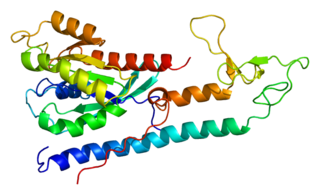Rab escort protein 1 (REP1) also known as rab proteins geranylgeranyltransferase component A 1 is an enzyme that in humans is encoded by the CHM gene. [5] [6]
Rab escort protein 1 (REP1) also known as rab proteins geranylgeranyltransferase component A 1 is an enzyme that in humans is encoded by the CHM gene. [5] [6]
This gene encodes component A of the RAB geranylgeranyl transferase holoenzyme. In the dimeric holoenzyme, this subunit binds unprenylated Rab GTPases and then presents them to the catalytic Rab GGTase subunit for the geranylgeranyl transfer reaction. Rab GTPases need to be geranylgeranyled on either one or two cysteine residues in their C-terminus to localize to the correct intracellular membrane. [6]
CHM (gene) has been shown to interact with RAB1A, [7] RAB7A [8] [9] and RAB3A. [7] [10]
Mutations in this gene are a cause of choroideremia; also known as tapetochoroidal dystrophy (TCD). This X-linked disease is characterized by progressive dystrophy of the choroid, retinal pigment epithelium and retina. [6]
The Rab family of proteins is a member of the Ras superfamily of small G proteins. Approximately 70 types of Rabs have now been identified in humans. Rab proteins generally possess a GTPase fold, which consists of a six-stranded beta sheet which is flanked by five alpha helices. Rab GTPases regulate many steps of membrane trafficking, including vesicle formation, vesicle movement along actin and tubulin networks, and membrane fusion. These processes make up the route through which cell surface proteins are trafficked from the Golgi to the plasma membrane and are recycled. Surface protein recycling returns proteins to the surface whose function involves carrying another protein or substance inside the cell, such as the transferrin receptor, or serves as a means of regulating the number of a certain type of protein molecules on the surface.

Prenylation is the addition of hydrophobic molecules to a protein or a biomolecule. It is usually assumed that prenyl groups (3-methylbut-2-en-1-yl) facilitate attachment to cell membranes, similar to lipid anchors like the GPI anchor, though direct evidence of this has not been observed. Prenyl groups have been shown to be important for protein–protein binding through specialized prenyl-binding domains.

Choroideremia is a rare, X-linked recessive form of hereditary retinal degeneration that affects roughly 1 in 50,000 males. The disease causes a gradual loss of vision, starting with childhood night blindness, followed by peripheral vision loss and progressing to loss of central vision later in life. Progression continues throughout the individual's life, but both the rate of change and the degree of visual loss are variable among those affected, even within the same family.

Rab geranylgeranyltransferase also known as (protein) geranylgeranyltransferase II is one of the three prenyltransferases. It transfers (usually) two geranylgeranyl groups to the cystein(s) at the C-terminus of Rab proteins.

In molecular biology, the Guanosine dissociation inhibitors (GDIs) constitute a family of small GTPases that serve a regulatory role in vesicular membrane traffic. GDIs bind to the GDP-bound form of Rho and Rab small GTPases and not only prevent exchange, but also prevent the small GTPase from localizing at the membrane, which is their place of action. This inhibition can be removed by the action of a GDI displacement factor. GDIs also inhibit cdc42 by binding to its tail and preventing its insertion into membranes; hence it cannot trigger WASPs and cannot lead to nucleation of F-actin.

Melanophilin is a carrier protein which in humans is encoded by the MLPH gene. Several alternatively spliced transcript variants of this gene have been described, but the full-length nature of some of these variants has not been determined.

Ras-related protein Rab-5A is a protein that in humans is encoded by the RAB5A gene.

Ras-related protein Rab-7a is a protein that in humans is encoded by the RAB7A gene.

Ras-related protein Rab-6A is a protein that in humans is encoded by the RAB6A gene located in the eleventh chromosome. Its main function is the regulation of protein transport from the Golgi complex to the endoplasmic reticulum and the exocytosis along with the microtubules.

Rab GDP dissociation inhibitor alpha is a protein that in humans is encoded by the GDI1 gene.

Ras-related protein Rab-3A is a protein that in humans is encoded by the RAB3A gene. It is involved in calcium-triggered exocytosis in neurons.

X-linked retinitis pigmentosa GTPase regulator is a GTPase-binding protein that in humans is encoded by the RPGR gene. The gene is located on the X-chromosome and is commonly associated with X-linked retinitis pigmentosa (XLRP). In photoreceptor cells, RPGR is localized in the connecting cilium which connects the protein-synthesizing inner segment to the photosensitive outer segment and is involved in the modulation of cargo trafficked between the two segments.

Ras-related protein Rab-1A is a protein that in humans is encoded by the RAB1A gene.

Crumbs homolog 1 is a protein that in humans is encoded by the CRB1 gene.

Gamma-crystallin B is a protein that in humans is encoded by the CRYGB gene.

Ras-related protein Rab-1B is a protein that in humans is encoded by the RAB1B gene.

Rab proteins geranylgeranyltransferase component A 2 is an enzyme that in humans is encoded by the CHML gene.

Ras-related protein Rab-21 is a protein that in humans is encoded by the RAB21 gene.

Ras-related protein Rab-27A is a protein that in humans is encoded by the RAB27A gene.

Ras-related protein Rab-8B is a protein that in humans is encoded by the RAB8B gene.